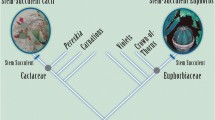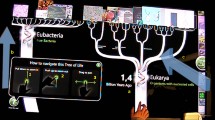Abstract
In this paper we present a qualitative analysis of natural history museum visitor interaction around a multi-touch tabletop exhibit called DeepTree that we designed around concepts of evolution and common descent. DeepTree combines several large scientific datasets and an innovative visualization technique to display a phylogenetic tree of life consisting of over 70,000 species. After describing our design, we present a study involving pairs of children interacting with DeepTree in two natural history museums. Our analysis focuses on two questions. First, how do dyads negotiate their moment-to-moment exploration of the exhibit? Second, how do dyads develop and negotiate their understanding of evolutionary concepts? In order to address these questions we present an analytical framework that describes dyads’ exploration along two dimensions: coordination and target of action. This framework reveals four distinct patterns of interaction, which, we argue, are relevant for similar interactive designs. We conclude with a discussion of the role of design in helping visitors make sense of interactive experiences involving the visualization of large scientific datasets.



Similar content being viewed by others
Notes
Note: In transcribed excerpts, numbers in rounded parentheses represent pauses in seconds (e.g., 0.7 connotes a pause of 7 tenths of a seconds), parentheses surrounding a period represent a micro-pause, and colons within words (e.g., re::lat::ed) describe degrees of elongation in speech.
References
Allen, S. (2004). Designs for learning: Studying science museum exhibits that do more than entertain. Science Education, 88(1), 17–S33.
Allen, S., & Gutwill, J. (2004). Designing with multiple interactives: Five common pitfalls. Curator: The Museum Journal, 47(2), 199–212.
Antle, A. N., Tanenbaum, J., Seaborn K., Bevans, A., & Wang, S. (2011). Futura: Design for collaborative learning and game play on a multi-touch digital tabletop. In Proceedings of Conference on Tangible, Embedded and Embodied Interaction (TEI’11) (pp. 93–100). ACM Press.
Ash, D. (2004). How families use questions at dioramas: Ideas for exhibit design. Curator: The Museum Journal, 47(1), 84–100.
Baum, D. A., Smith, S. D., & Donovan, S. S. S. (2005). The tree-thinking challenge. Science, 310, 979–980.
Block, F., Horn, M., Phillips, B. C., Diamond, J., Evans, M., & Shen, C. (2012). The DeepTree exhibit: Visualizing the tree of life to facilitate informal earning. IEEE Transactions on Visualization and Computer Graphics (TVCG), 18(12), 2789–2798.
Catley, K. M., & Novick, L. R. (2008). Seeing the wood for the tree: An analysis of evolutionary diagrams in biology textbooks. Bioscience, 58(10), 976–987.
Crowley, K., Callanan, M. A., Jipson, J. L., Galco, J., Topping, K., & Shrager, J. (2001). Shared scientific thinking in everyday parent–child activity. Science Education, 85(6), 712–732.
Davis, P. R., Horn, M. S., & Sherin, B. L. (2013). The right kind of wrong: A “Knowledge in Pieces” approach to science learning in museums. Curator: The Museum Journal, 56(1), 31–46.
Dillenbourg, P., & Evans, M. (2011). Interactive tabletops in education. International Journal of Computer-Supported Collaborative Learning, 6(4), 491–514.
Eberbach, C., & Crowley, K. (2005). From living to virtual: Learning from museum objects. Curator: The Museum Journal, 48(3), 317–338.
Falk, J. H. (2009). Identity and the museum visitor experience. Left Coast Press.
Falk, J. H., & Dierking, L. D. (2000). Learning from museums: Visitor experiences and the making of meaning. Altamira Press.
Falk, J., & Storksdieck, M. (2005). Using the contextual model of learning to understand visitor learning from a science center exhibition. Science Education, 89(5), 744–778.
Fleck, R., Rogers, Y., Yuill, N., Marshall, P., Carr, A., Rick, J., & Bonnett, V. (2009). Actions speak loudly with words: Unpacking collaboration around the table. In Proc. interactive tabletops and surfaces ITS’09 (pp. 189–196). ACM Press.
Goffman, E. (1974). Frame Analysis. New York: Harper Colophon Books.
Gregory, R. T. (2008). Understanding evolutionary trees. Evolution Education and Outreach, 1, 121–137.
Hall, R. (2000). Video recording as theory. Handbook of research design in mathematics and science education (pp. 647–664).
Hammer, D., & Berland, L. K. (2014). Confusing claims for data: A critique of common practices for presenting qualitative research on learning. The Journal of the Learning Sciences, 23(1), 37–46.
Higgins, S. E., Mercier, E., Burd, E., & Hatch, A. (2011). Multi-touch tables and the relationship with collaborative classroom pedagogies: A synthetic review. International Journal of Computer-Supported Collaborative Learning, 6(4), 515–538.
Hinrichs, U., & Carpendale, S. (2011). Gestures in the wild: Studying multi-touch gesture sequences on interactive tabletop exhibits. In Proceedings of the SIGCHI Conference on Human Factors in Computing Systems (pp. 3023–3032). ACM.
Horn, M., Atrash Leong, Z., Block, F., Diamond, J., Evans, E. M., Phillips, B., & Shen, C. (2012, May). Of BATs and APEs: An interactive tabletop game for natural history museums. In Proceedings of the SIGCHI Conference on Human Factors in Computing Systems (pp. 2059–2068). ACM.
Horn, M. S., Phillips, B., Evans, E. M., Block, F., Diamond, J., & Shen, C. (Under Review). Bringing “big data” to the table: Learning science in museums through an information visualization. Manuscript submitted for review.
Hornecker, E. (2008, October). “I don’t understand it either, but it is cool”-visitor interactions with a multi-touch table in a museum. In Horizontal interactive human computer systems, 2008. TABLETOP 2008. 3rd IEEE International Workshop on (pp. 113–120). IEEE.
Humphrey, T., & Gutwill, J. P. (2005). Fostering active prolonged engagement: The art of creating APE exhibits. San Francisco: Left Coast Press.
Jordan, B., & Henderson, A. (1995). Interaction analysis: Foundations and practice. The Journal of the Learning Sciences, 4(1), 39–103.
Louw, M., & Crowley, K. (2013). New ways of looking and learning in natural history museums: The use of gigapixel imaging to bring science and publics together. Curator: The Museum Journal, 56(1), 87–104.
Ma, J., Liao, I., Ma, K. L., & Frazier, J. (2012). Living liquid: Design and evaluation of an exploratory visualization tool for museum visitors. IEEE Transactions on Visualization and Computer Graphics, 18(12), 2799–2808.
MacDonald, T., & Wiley, E. O. (2010). Communicating phylogeny: evolutionary tree diagrams in museums. Evolution: Education and Outreach, 1–15.
Marshall, P., Fleck, R., Harris, A., Rick, J., Hornecker, E., Rogers, Y., Yuill, N., & Dalton, N. S. (2009). Fighting for control: Children’s embodied interactions when using physical and digital representations. In Proc. ACM conference on human factors in computing systems, CHI’09 (pp. 2149–2152). ACM Press.
Matuk, C. F., & Uttal, D. H. (2012). Narrative spaces in the representation and understanding of evolution. In K. Rosengren et al. (Eds.), Evolution challenges: Integrating research and practice in teaching and learning about evolution. New York: Oxford University Press.
Miles, M. B., & Huberman, A. M. (1994). Qualitative data analysis: An expanded sourcebook. Sage.
Miller, J. D., Scott, E. C., & Okamoto, S. (2006). Public acceptance of evolution. Science, 313, 765–766.
Novick, L. R., Stull, A. T., & Catley, K. M. (2012). Reading phylogenetic trees: Effects of tree orientation and text processing on comprehension. BioScience, 62, 757–764.
Olson, I. C., Leong, Z. A., Wilensky, U., Horn, M. S. (2011). It’s just a toolbar!: Using tangibles to help children manage conflict around a multi-touch tabletop. In Proc. tangible, embedded, and embodied interaction TEI’11 (pp. 29–36). ACM Press.
Oppenheimer, F. (1976). Everyone is you… or me. Technology Review, 78(7).
Pontual Falcão, T., & Price, S. (2011). Interfering and resolving: How tabletop interaction facilitates co-construction of argumentative knowledge. Computer-Supported Collaborative Learning, 6, 539–559.
Price, S., & Pontual Falcão. (2011). Where the attention is: Discovery learning in novel tangible environments. Interacting with Computers, 23, 499–512.
Prum, A. J. (Producer). (2008). Discovering the Great Tree of Life. Available from the Peabody Museum of Natural History, Yale University, P.O. Box 208118, New Haven, CT. http://archive.peabody.yale.edu/exhibits/treeoflife/film_discovering.html.
Rick, J., Marshall, P., & Yuill, N. (2011). Beyond one-size-fits-all: How interactive tabletops support collaborative learning. In Proc. interaction design and children IDC’11 (pp. 109–117). ACM Press.
Roberts, J., Lyons, L., Cafaro, F., & Eydt, R. (2014). Interpreting data from within: Supporting human-data interaction in museum exhibits through perspective taking. In Proceedings of Interaction Design and Children (pp. 7–16). ACM Press.
Rosengren, K. S., Brem, S. K., Evans, E. M., & Sinatra, G. M. (Eds.). (2012). Evolution challenges: Integrating research and practice in teaching and learning about evolution. New York: Oxford University Press.
Schneider, B., Strait, M., Muller, L., Elfenbein, S., Shaer, O., & Shen, C. (2012). Phylo-Genie: Engaging students in collaborative “tree-thinking” through tabletop techniques. In Proc. human factors in computing systems (CHI’12) (pp. 3071–3080). ACM.
Scott, S. D., Mandryk, R. L., & Inkpen, K. M. (2003). Understanding children’s collaborative interactions in shared environments. Journal of Computer Assisted Learning, 19, 220–228.
Shaer, O., Strait, M., Valdes, C., Feng, T., Lintz, M., & Wang, H. (2011). Enhancing genomic learning through tabletop interaction. In Proc. human factors in computing systems (CHI’11) (pp. 2817–2826). ACM.
Snibbe, S. S., & Raffle, H. S. (2009). Social immersive media: Pursuing best practices for multi-user interactive camera/projector exhibits. In Proceedings of the SIGCHI Conference on Human Factors in Computing Systems (pp. 1447–1456). ACM.
Stevens, R., & Hall, R. (1997). Seeing tornado: How video traces mediate visitor understandings of (natural?) phenomena in a science museum. Science Education, 81(6), 735–747.
Suchman, L. (2007). Human-machine reconfigurations: Plans and situated action. Cambridge: Cambridge University Press.
Weinberger, A., & Fischer, F. (2006). A framework to analyze argumentative knowledge construction in computer-supported collaborative learning. Computers and Education, 46(1), 71–95.
Author information
Authors and Affiliations
Corresponding author
Rights and permissions
About this article
Cite this article
Davis, P., Horn, M., Block, F. et al. “Whoa! We’re going deep in the trees!”: Patterns of collaboration around an interactive information visualization exhibit. Intern. J. Comput.-Support. Collab. Learn. 10, 53–76 (2015). https://doi.org/10.1007/s11412-015-9209-z
Received:
Accepted:
Published:
Issue Date:
DOI: https://doi.org/10.1007/s11412-015-9209-z




